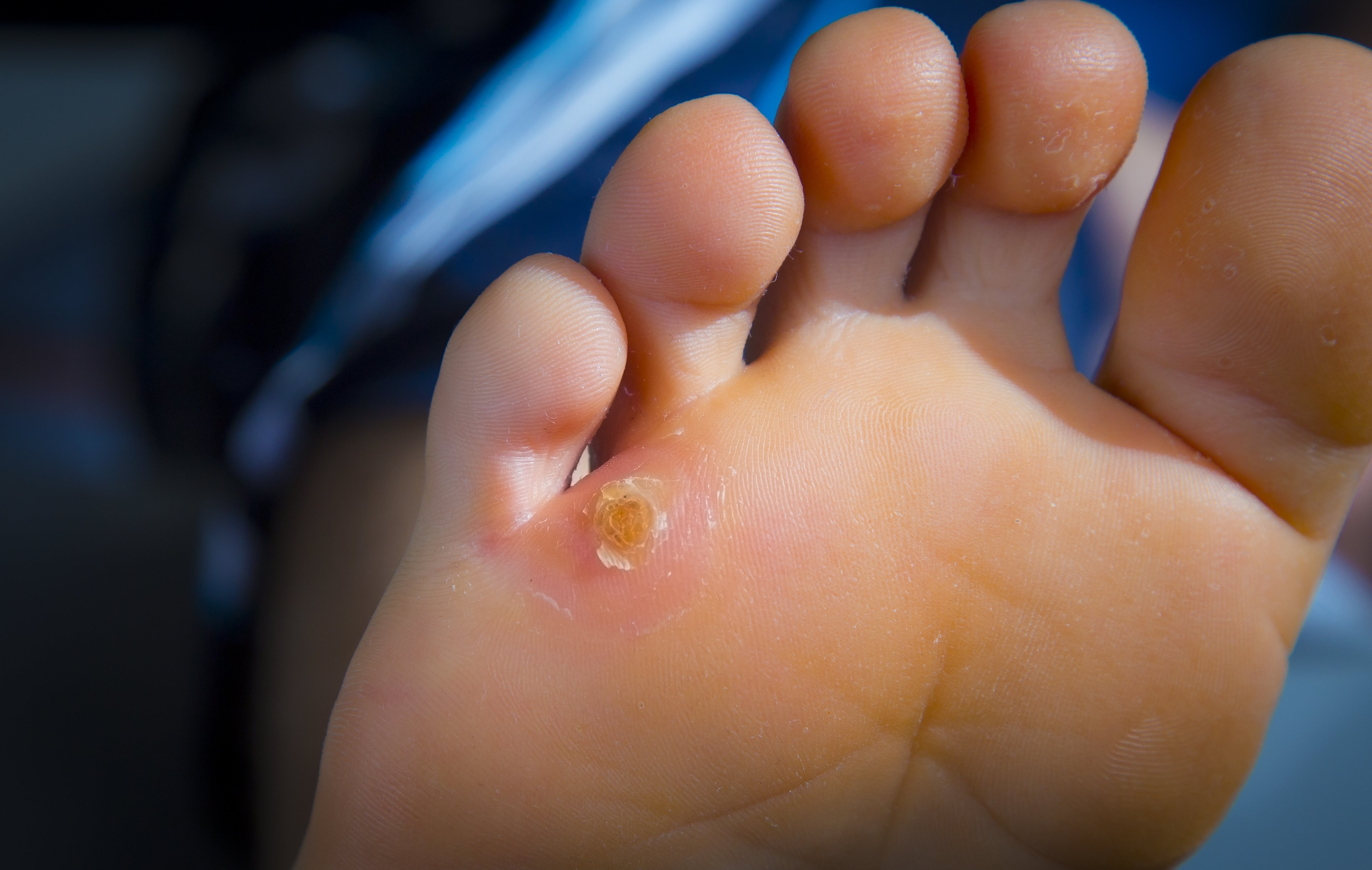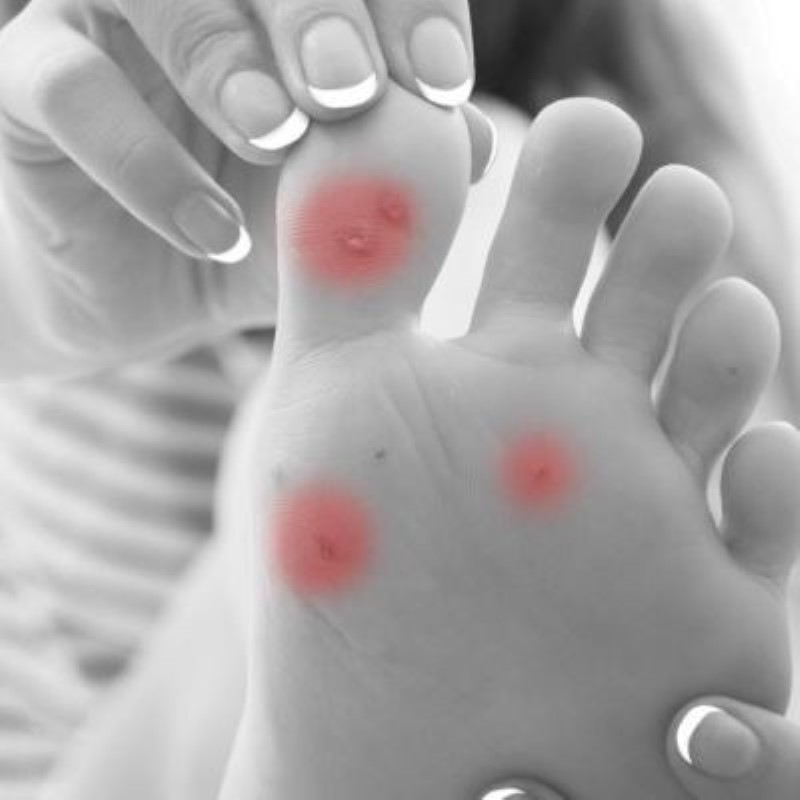Laser Foot Corn Removal in Rajkot
A corn is a small area of hardened skin that develops on areas of the feet that sustain too much compression or pressure.
Their size varies from small to large and consist of three different types:
- Hard corns: They comprise small patches of hard dead skin. They usually appear on the toes. The bone pressure falling over this region results in a hard corn.
- Soft corns: This category of corns is softer and has a rubbery feel when touched. They are usually grey or white and form in the region between toes.
- Seed corns: This is a smaller form of corn that usually appears on the underside of the feet.
They form to protect the underlying skin and can be very painful.
Corns have what is called, a nucleus, which refers to a deep centre or core. These are sometimes called roots.
A corn looks like a small bump of thick, hardened skin, and is usually yellow in colour.
The skin surrounding the corn may or may not be inflamed.

Corns are difficult to treat at home because they tend to be relatively small and have a deep core that needs to be removed for effective relief.
A dermatologist can remove all hardened skin including the core as part of corn treatment.
If your corn is painful and it affects your daily activities, or looks inflamed or discoloured (i.e. purple, brown, red), see a foot specialist for treatment.
Pain is your body’s way of telling you that something is not right so do not ignore it.
When corns are left for long periods of time, the healthy skin underneath can break down and result in an ulcer or wound in the foot.
If you have diabetes, see a dermatologist for corn treatment as soon as possible.
Yes. Corn removals are usually painless and there is no down time.
Most people experience immediate relief after treatment and can go back to their normal routines feeling much better than they did before the appointment.
This will vary depending on your footwear choices, level of activity, and presence of and severity of digital deformities.
Most corns will require continuous periodic care and management.
Use of tight shoes
Using tight shoes is a common cause of corns. The inner surface of tight shoes rubs against the skin, causing pressure and friction. For instance, women who use high-heels develop corns or calluses in the pressure points. and develop heel pain.
Improper use of shoes and socks:
- Not wearing shoes in rough terrain can cause corns
- Not using a pair of socks with shoes can increase friction on your feet and lead to corns
- If your socks slip and cluster inside your shoes, you may develop corns
Physical activity
- Physical movements with intense exercise for long periods can cause corns in areas of skin contact. For instance, walking and running can lead to corns.
- Activities which exert pressure on a specific region of your legs, hands, or fingers also lead to corns
Incorrect posture
- Walking in the wrong posture can cause unexpected pressure and friction in areas not intended to take up leading to corns.
- Deformities by birth or hammertoes can lead to corns on foot.
Complications or risk factors
The presence of a few risk factors may increase the risk of contracting corns. Here are some complications that can arise –
- Foot deformities: The presence of a bone spur or other abnormalities in your toes causes irritation within your shoe eventually leading to corns.
- Hammertoes: In this condition, your toes curl inwards, increasing friction when using shoes.
- Bunions: These are thick bumps that form close to the joint that holds your largest toe. causing corns.
- Exposed hands: Using bare hands for intense activities like construction, mechanical jobs, or gym workout can lead to corns.
Before treating the corn, you should understand the triggering factor. By removing the factor causing friction or pressure, you can cure the condition in most cases.
If this does not help, consider the following measures:
- Take away the source of friction: By removing the source of friction, the corn may recede. By using the right fitting shoes or socks. Proper protection is ensured while doing activities that put excessive pressure on the skin.
- File the corn away: Remove the corn by filing. First, soak the corn in warm water for 20 minutes. Then remove your feet from water and gently scrape off dead skin. Use a pumice stone, emery boards (the rough part of nail-cutters), or foot brushes to file the corn. Remember not to file too much skin which may lead to bleeding and infection.
- Apply products containing salicylic acid: Ointments, scrubs, and lotions containing salicylic acid are effective in removing corns. Apply these on your corn. Dip your feet in warm water before scraping them off gently as above. The presence of salicylic acid makes the removal of dead skin easier.
If you have a skin problem, consult your doctor before using products with salicylic acid. Avoid using it if you have diabetes and poor circulation. - Use corn pads: You can also use corn pads smeared with a lotion containing salicylic acid which prevents further friction on the affected area and supports the easy removal of dead cells
If this does not help, consider Laser corn removal by dermatologist in Rajkot.
5. Laser Corn Removal: Here corn is removed by laser machine under Local anesthesia and no stitches are required. (Most Recommended)
6. Surgery: Here corn is excised via scalpel blade and stitches are taken.
Taking appropriate measures can keep away corns. Here are a few tips:
- Wear right-sized shoes and socks: Measure your feet correctly before buying shoes and socks. This will ensure the right fit and prevent excessive pressure on your feet.
- Wear corn pads: Use foam, or felt cloth as corn pads. This will prevent excess pressure arising from contact between skin and shoes.
- Keep the feet moisturized: Dryness induces more friction on the skin. Hence, moisturizing creams can help prevent corn formation4. However, l do not use moisturizers with alcohol as they can cause additional dryness.
- Keep your feet clean: Cleaning your feet regularly ensures timely removal of dead cells which prevents corn formation.
- Trim your nails: Trim your nails regularly. as they may push against the shoes or push neighbouring toes, causing corn formation.
- Use gloves while doing an intense activity: use protection, if you do physical activities that require skin contact. For instance, use a pair of gloves if you workout in the gym or do construction work.
Leaving a corn untreated may lead to acute pain. Sometimes it might get infected by bacteria, and spread, causing cellulitis or infect nearby bone tissue and tendon. This condition is Osteomyelitis













